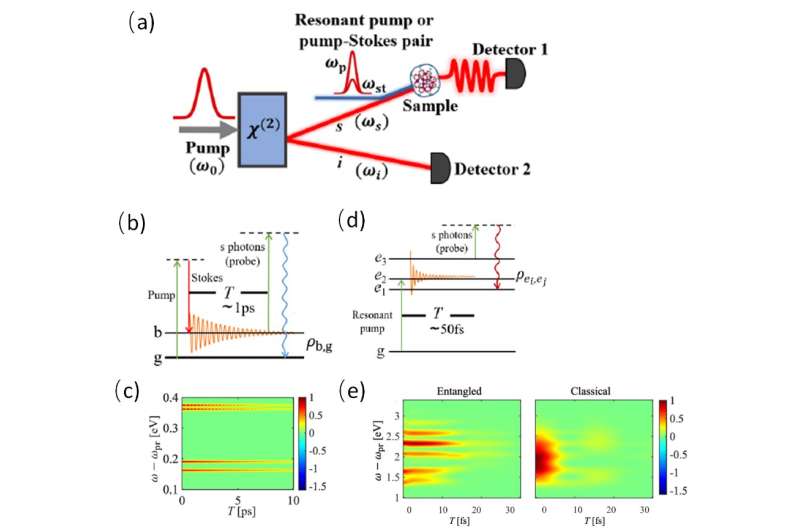Super-resolved coherent Raman spectroscopy with quantum light

In recent years, entangled photons—a popular quantum light source—have been widely used in quantum imaging, optical interferometry, quantum computing, quantum communication, and other fields. Spontaneous parametric down-conversion generates the entangled photon pairs with conserved energy and momentum, so that the quantum correlation in space and time is encoded. Such a property enables a quantum advantage that overcomes the diffraction limit of classical pulses in the field of imaging and detection.
One of the long-existing bottleneck problems in molecular spectroscopy is detecting ultrafast electronic processes on the femtosecond scale. The dynamics of electron coherence are particularly important. However, limited by the time-frequency resolution and the incoherent channels of excited states, existing Raman technology cannot be used to this end.
In a newly-published paper in Light: Science & Applications, Professor Zhedong Zhang from Department of Physics at City University of Hong Kong and co-workers have developed a femtosecond time-resolved coherent Raman spectroscopy with entangled photons that leads to QFRS (Quantum femtosecond Raman spectroscopy).
Specifically, a super-resolved nature of the Raman signal resulting from a manipulation of photon entanglement is shown in their work—both the temporal and spectral resolutions can be achieved simultaneously. The QFRS is sensitive to the electronic coherence only.
This makes it uniquely suitable for detecting the electronically excited-state dynamics during a short timescale ~50 fs. Such an advantage is not attainable in the Raman techniques studied previously, which were bottlenecked by either the fast decay or the time-frequency resolutions. The work offers new perspective for investigating the ultrafast processes in complex materials such as molecules, 2D materials and exciton, polaritons as we can extract the desired relaxation and radiative processes.
The quantum Raman Spectroscopy replaces the classical probe pulse with a signal-photon beam from the entangled photon source. The idler photon beam serves as the heralded beam for the coincidence measurement. The temporal and spectral resolutions can be therefore controlled independently. This results in the super-resolved nature beyond the conjugation of the time-frequency relationship. The heterodyne detection can be made further to monitor the phase of electrons. The highlighting spots of their work are summarized as follows:
"We design a quantum version of femtosecond Raman spectroscopy for three purposes: (1) to perform high-resolution anti-stokes Raman spectroscopy in real-time domain; (2) to be able to image electron dynamics during ultrashort timescale; and (3) to be sensitive to the phase of molecular excitations so that let the detection sensitivity beat the stand quantum limit."
"Our work considerably expands the horizon of the entangled light and compliments spectroscopic advances made by entangled light in the context of the optimal two photon absorption processes in complex molecules. This work will help future experimental and theoretical efforts," the scientists said.
More information: Zhedong Zhang et al, Entangled photons enabled time-frequency-resolved coherent Raman spectroscopy and applications to electronic coherences at femtosecond scale, Light: Science & Applications (2022). DOI: 10.1038/s41377-022-00953-y
Journal information: Light: Science & Applications
Provided by Chinese Academy of Sciences


















